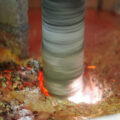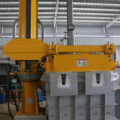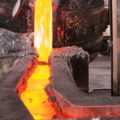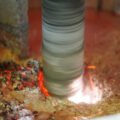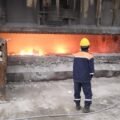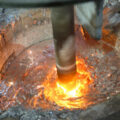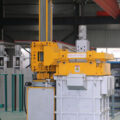Online degassing system can reduce the accumulation of gas and the problems, and achieve the highest refining efficiency.
A major disadvantage of conventional reactors is that bubbles will aggregate after being injected into the aluminum melt. Gas accumulation greatly limits the refining speed. As the bubbles rise to the surface, the accumulation of gas will form smaller and larger bubbles. Large bubbles will increase the disturbance to the interface between the aluminum melt and the scum layer, resulting in a certain amount of backflow, so that the impurities in the scum will enter the molten aluminum again. Smaller bubbles reaching the top of the aluminum melt can minimize this source of pollution.
More importantly, the contact area between gas and molten metal is greatly reduced due to the accumulation of bubbles into larger bubbles. This will lead to a significant reduction in the refining reaction rate, because this reaction only occurs at the gas-metal interface. Hydrogen has high dispersibility in aluminum melt, and the transfer reaction is mainly controlled by the interface area. The larger the interface area, the shorter the time required to reach a certain degree of outgassing.
Moreover, the larger the interface area, the more opportunities for bubbles to encounter and trap impurities. Therefore, the larger the interface area, the higher the degassing refining efficiency. As the number of bubbles decreases and the contact area between gas and metal decreases, the probability of contact, adhesion or reaction of a certain category of impurities with bubbles will be greatly reduced.
Influence of refined gas temperature
When the cold gas is injected into the molten metal in the form of fine bubbles, the gas will expand rapidly in accordance with the ideal gas law to form larger bubbles. From room temperature to molten aluminum temperature, the volume of the refining process gas (Ar or N2) will expand three times. If this expansion is not allowed to occur before the gas is cut into tiny bubbles, the expansion of the bubbles will result in reduced efficiency.
Moreover, the expansion of the bubble volume will increase the buoyancy of the bubble and its upward movement speed in the melt. Therefore, before the gas enters the molten metal, it is extremely important to preheat it to close to the temperature of the molten aluminum. In the online degassing system, the preheating of the gas is realized by its own delicate device. It makes the gas flow between the inner wall of the graphite sleeve and the grooves machined on the outer surface of the rotating shaft, which increases the flow path of the gas on the rotating shaft by 20 times. The large gas surface allows heat to be quickly transferred from the sleeve (or reactor) to the moving gas.


